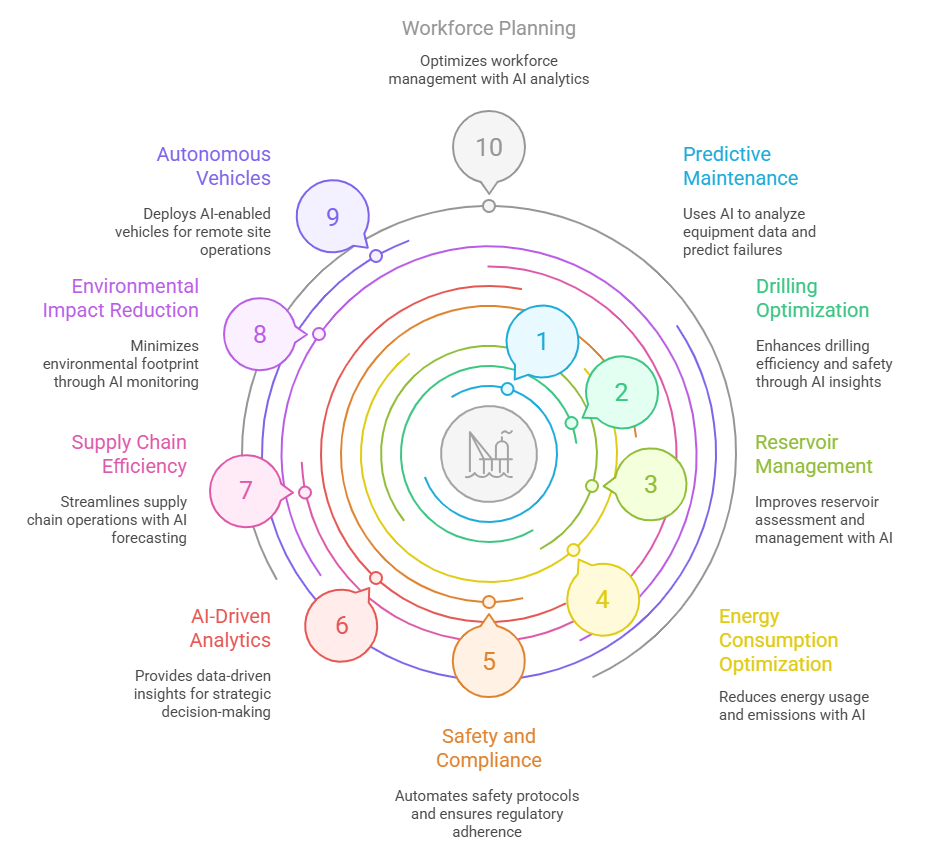This article explores the impact, key use cases, and benefits of AI in the oil and gas industry, supported by real-world case studies.
Artificial Intelligence is revolutionizing the oil and gas sector, offering smarter, faster, and more cost-effective solutions across extraction, processing, and distribution. By adopting AI in oil and gas industry, companies are optimizng operations, cutting costs, and boosting profits with advanced tools like generative AI for seismic analysis.
A recent IBM report highlights the swift integration of AI throughout the oil and gas sector. In the upstream segment, 44% of exploration and production companies are already using AI, while an additional 45% intend to adopt it within the next three years. The downstream sector shows a similar trend, with 41% currently leveraging AI and 52% planning to implement it soon.
Impact of AI in Oil and Gas Industry
AI is revolutionizing the oil and gas industry by improving efficiency, safety, and profitability across operations. A key application is predictive maintenance, where AI analyzes sensor data from equipment to predict potential failures. This enables proactive maintenance, minimizing unexpected downtime, reducing repair costs, and extending the life of essential machinery.
As companies in the sector continue to digitally transform, many are turning to AI ML services to unlock smarter decision-making and faster innovation. From reservoir analysis to supply chain optimization, these services enable the deployment of AI models that provide real-time insights and automation at scale. By integrating AI capabilities, oil and gas enterprises can address operational complexities with agility and precision.
The global AI market in the oil and gas sector is expected to grow substantially, reaching around USD 3 billion in 2024 and rising to USD 5.2 billion by 2029, highlighting its rapidly increasing adoption and value.
AI plays a pivotal role in improving drilling efficiency. By leveraging advanced algorithms to analyze geological data, companies can pinpoint the most effective drilling locations, which enhances resource extraction while lowering costs and environmental risks. This data-driven strategy ensures greater drilling precision and operational optimization. In terms of energy management, AI supports real-time tracking and analysis of energy usage, enabling organizations to streamline consumption, cut costs, and shrink their carbon footprint.
The economic benefits of AI in the oil and gas sector are noteworthy. It can significantly reduce production expenses, with projections indicating savings of up to $5 per barrel through a 25% boost in productivity. Moreover, AI can enhance resource recovery, potentially increasing oil reserves by 8% to 20%.
Key Use Cases: AI in Oil and Gas Industry
Artificial Intelligence is swiftly emerging as a vital asset in the oil and gas sector, offering diverse applications that optimize operations, support smarter decision-making, boost safety standards, and minimize environmental impact.

Predictive Maintenance and Equipment Monitoring
Predictive maintenance is one of the most impactful applications of AI in oil and gas industry. The sector relies heavily on complex machinery such as pumps, turbines, and compressors, and any equipment failure can lead to significant repair costs and unplanned downtime, affecting overall productivity.
Using machine learning, AI systems analyze large volumes of sensor data from equipment in real time. These sensors monitor variables like temperature, pressure, and vibration. AI algorithms process this data to identify potential failures before they happen, allowing companies to carry out maintenance proactively.
Drilling Optimization
AI is becoming a key enabler in improving drilling operations within the oil and gas industry. Drilling remains a high-cost and high-risk process due to the complexity of underground geological formations. With the help of AI, companies can analyze large volumes of geological data to pinpoint the most viable drilling locations and determine the most effective methods for resource extraction.
Machine learning models process data from seismic surveys, past drilling activities, and real-time operations to generate actionable insights. These insights help adjust critical drilling parameters such as mudflow rates and penetration speed, improving operational efficiency and reducing risks like blowouts or equipment getting stuck.
Reservoir Management and Exploration
AI is increasingly being used in reservoir management and exploration within the oil and gas industry. Traditionally, identifying and assessing oil and gas reserves required intensive geophysical and geochemical analysis, heavily dependent on expert interpretation. Today, AI optimizes this process by delivering faster and more precise evaluations of reservoir properties.
By learning from historical and real-time sensor data, machine learning models can predict how reservoirs will behave under various conditions. These AI-driven insights help companies estimate the size and productivity of reserves more accurately, guiding smarter investment decisions in exploration and extraction.
Energy Consumption Optimization
AI is significantly changing the way oil and gas companies manage their energy usage. Given the industry’s large carbon footprint, there is growing pressure to enhance energy efficiency and reduce emissions. AI supports these sustainability efforts by helping optimize energy consumption across various operations.
With real-time monitoring capabilities, AI systems can track energy use, detect inefficiencies, and identify opportunities to reduce consumption. These intelligent systems can also adjust operational processes based on current energy demand and supply conditions, ensuring more efficient energy usage.
Automation of Safety and Compliance
Safety and regulatory compliance are critical concerns in the oil and gas industry, where workers often operate in hazardous environments and face strict oversight. AI is playing an increasingly important role in automating safety protocols and ensuring adherence to industry regulations, all while enhancing worker protection.
AI systems can monitor equipment performance and worker activity to identify potential safety risks. For instance, data from drones and wearable devices can be analyzed in real time to track workers’ locations, monitor vital signs, and ensure safe working conditions. AI can also automate equipment safety checks, verifying that systems are functioning properly before operations begin.
AI-Driven Analytics in Oil & Gas Industry
Artificial Intelligence is reshaping decision-making in the oil and gas sector by offering actionable insights that support data-driven strategies. Traditionally, the industry relied on expert judgment and historical experience. While this approach is still important, AI brings added value by analyzing large volumes of data from various sources to uncover patterns and trends that might otherwise remain hidden.
AI-powered analytics support more informed decisions in key areas such as resource allocation, investment planning, and risk management. For example, AI can analyze market conditions to forecast oil prices and highlight factors that impact production and exploration.
Enhancing Supply Chain Efficiency with AI in Oil and Gas
Managing a complex supply chain is essential in the oil and gas sector to ensure timely and cost-effective delivery of materials and equipment. Artificial Intelligence is aiding companies in streamlining their supply chains by advancing demand forecasting, inventory oversight, and logistics coordination.
AI technologies can evaluate past data on supply and demand, weather trends, and other external variables to forecast the need for supplies at different operational sites. This forecasting ability helps businesses maintain optimal inventory levels and prevent disruptions. AI also contributes to improving logistics by determining the best transportation routes and reducing fuel usage.
Reducing Environmental Impact with AI in Oil and Gas
As environmental concerns grow, the oil and gas industry is under mounting pressure to lower greenhouse gas emissions and improve waste management practices. Artificial Intelligence is becoming a vital tool in tackling these issues by enhancing resource efficiency, minimizing waste, and strengthening environmental monitoring efforts.
AI-driven technologies can process environmental data in real time to pinpoint areas with excessive emissions or waste. For instance, AI can track methane leaks from pipelines or drilling platforms and notify operators when levels surpass safety limits. This real-time detection allows companies to respond quickly, lowering their environmental footprint and helping them avoid penalties or damage to their public image.
Advancing Operations with AI-Driven Autonomous Vehicles
The integration of Artificial Intelligence is making autonomous vehicles increasingly common in the oil and gas industry. Drones and self-driving machines are being deployed to oversee remote sites, inspect infrastructure, and transport supplies. AI-enabled drones can examine pipelines, refineries, and oil rigs, identifying defects or safety risks that might escape human observation.
These autonomous systems are also used for moving equipment, tools, and personnel to isolated locations. By reducing the reliance on human drivers, AI-powered vehicles help lower operational costs, enhance workplace safety, and lessen the environmental impact of transportation activities.
Workforce Planning and Talent Management with AI
Artificial Intelligence is changing the way oil and gas companies plan and manage their workforce. With challenges such as an aging labor force, evolving skill requirements, and hazardous work environments, AI provides advanced solutions for efficient talent management and strategic workforce planning.
AI systems can analyze employee data, project schedules, and industry trends to forecast labor demands and identify skill gaps. This helps companies streamline recruitment, ensure timely hiring, and align talent with operational needs.
Benefits of AI in the Oil and Gas Industry
Artificial intelligence is bringing major advantages to the oil and gas sector, helping businesses tackle the complexities and high costs of the industry. By boosting efficiency and minimizing environmental impact, AI is driving transformative change across operations.

Enhanced Operational Efficiency
AI plays a key role in boosting operational efficiency in the oil and gas sector by automating tasks that were traditionally handled manually. These manual processes are often slow and prone to errors, whereas AI delivers faster and more accurate insights that support better decision-making.
With AI-powered tools, companies can optimize operations across drilling, production, and transportation. Machine learning algorithms can process large volumes of data, such as drilling speeds, equipment performance, and environmental conditions, to spot inefficiencies and patterns. These insights help companies make real-time adjustments, reduce waste, improve production, and increase overall efficiency.
Cost Reduction and Resource Optimization
AI offers a significant advantage in the oil and gas industry by helping reduce costs and improve resource management. In a sector where profitability is critical, AI-driven solutions enable companies to cut operational expenses by boosting efficiency, minimizing downtime, and reducing waste.
A key example is predictive maintenance. By analyzing data from equipment sensors, AI can forecast potential failures, allowing maintenance to be scheduled before issues arise. This proactive strategy helps avoid costly emergency repairs and unplanned shutdowns, keeping operations smooth and more cost-effective.
Improved Safety and Risk Management
In the oil and gas sector, where hazardous conditions and high-risk operations are common, ensuring safety is critical. AI enhances safety measures by automating risk assessments and enabling real-time monitoring of equipment and personnel.
With AI-powered sensors and monitoring systems, companies can continuously track equipment performance and detect early warning signs of potential hazards. For instance, AI can process sensor data from drilling rigs, pipelines, or refineries to spot leaks, malfunctions, or unusual activity. This allows teams to act quickly, preventing incidents and minimizing downtime.
Sustainability and Environmental Impact Reduction
As regulatory and public pressure to reduce environmental harm grows, the oil and gas industry is increasingly turning to AI to support sustainability efforts. AI helps optimize resource extraction and lower carbon emissions, making operations more environmentally responsible.
AI systems can monitor environmental factors such as air and water quality, methane leaks, and overall pollution. By analyzing this data, AI can identify risks like excessive emissions or leaks and alert operators to take immediate corrective measures. For example, AI can track methane output from rigs or pipelines, helping companies minimize their carbon footprint and stay compliant with environmental regulations.
Enhanced Decision-Making and Data Analytics
AI provides a major advantage in the oil and gas industry by strengthening decision-making through advanced data analytics. The sector produces large volumes of data from drilling operations, equipment performance, and environmental sensors. Manually analyzing this information takes time, but AI can process it rapidly and deliver actionable insights.
With AI-driven analytics, companies can discover patterns and trends that traditional methods might overlook. For example, AI can examine seismic data to find the most promising drilling sites or predict reservoir performance under different scenarios. Machine learning algorithms can also use historical production data to fine-tune extraction methods and improve output.
Better Workforce Management
AI is playing a growing role in improving workforce management in the oil and gas sector by optimizing scheduling, training, and resource planning. AI-powered tools can evaluate employee performance, detect skill gaps, and suggest personalized training programs to prepare workers for the specific demands of the industry.
When it comes to scheduling, AI can assess operational data to forecast labor needs based on production timelines, weather patterns, and equipment status. This enables companies to allocate their workforce more effectively, ensuring the right personnel are assigned at the right time while avoiding issues like overstaffing or shortages.
Faster and More Accurate Decision-Making
AI enhances the speed and precision of decision-making in the oil and gas industry by delivering real-time insights from large volumes of data. In such a fast-moving sector, the ability to make timely and informed decisions is crucial for maintaining smooth and efficient operations.
For example, AI can monitor live data from drilling activities to detect unusual pressure or temperature readings and recommend immediate corrective measures. This helps operators respond quickly to potential issues, preventing disruptions, minimizing downtime, and maintaining safety standards.
Real World Examples of How AI is Transforming Oil and Gas Industry
AI is playing a growing role in improving workforce management in the oil and gas industry. Below are some of the real-world examples of how AI is transforming oil and gas industry
Shell – Predictive Maintenance
With AI’s predictive capabilities, Shell reported a 20% decrease in maintenance costs, saving an estimated $2 billion annually. For a company that typically spends around $10 billion on maintenance per year, this is a game-changer. With advanced machine learning algorithms, Shell now predicts equipment failures before they occur, reducing unplanned downtime and extending asset lifespans. These AI-driven insights also help optimize field operations, allowing Shell to allocate resources more effectively across its global sites.
ExxonMobil – AI in Energy Trading
ExxonMobil has implemented AI algorithms to optimize its energy trading strategies. These algorithms analyze market data, pricing trends, and global supply-demand metrics in real time, allowing Exxon to make faster, data-driven trading decisions. As part of its broader digital transformation, which includes AI-driven trading and supply chain optimization, ExxonMobil has achieved $9.7 billion in structural cost savings, with a target of $15 billion by 2027. This use of AI improves profitability while reducing financial risk.
BP – AI for Seismic Data Interpretation
With AI for seismic data interpretation, BP has transformed its exploration process. Traditionally time-consuming and prone to error, seismic analysis is now faster and more precise thanks to machine learning algorithms. By partnering with Belmont Technologies to develop its “Sandy” AI platform, BP reduced seismic data interpretation time by up to 90%, cutting analysis from months to just days.
The company also achieved 98% accuracy in detecting downhole pressure anomalies, allowing it to place wells up to 90% faster in high-yield regions like Azerbaijan. These advancements have improved the accuracy of identifying viable drilling sites and enhanced overall efficiency. With AI-driven tools supporting exploration, BP has increased production by 4%, reduced unplanned outages by 10%, and significantly lowered exploration costs.
TotalEnergies – AI for Emission Monitoring
TotalEnergies uses AI to track and reduce methane emissions across its operations. By integrating AI with drone and satellite imagery, the company can accurately detect gas leaks and monitor environmental impact in real time. In one of its major initiatives, TotalEnergies committed to cutting methane emissions by 50% between 2020 and 2025 and achieved a 47% reduction by the end of 2023. This use of AI supports regulatory compliance and helps the company move closer to its sustainability and net-zero targets.
Final Thoughts
As AI in the oil and gas industry advances, its ability to manage complex decision-making will continue to grow, taking over responsibilities that were traditionally handled by humans. This development is set to transform operations, enhance safety protocols, and drive sustainability efforts. By adopting these technologies, companies can better respond to future challenges and tap into new opportunities in a market that is both competitive and environmentally aware.
Looking to enhance your app with AI? Intelegain helps forward-thinking entrepreneurs like you integrate advanced AI solutions into their applications. Let Intelegain help you unlock your app’s full potential and build something truly impactful. It’s time to take the next step in innovation. Let’s get started.
FAQs
AI is used to automate operations, analyze large volumes of data, predict equipment failures, optimize supply chains, improve safety, and enhance exploration processes.
AI-powered systems monitor pipelines, offshore platforms, and refineries in real time. Using sensors, drones, and machine learning, they detect leaks, pressure changes, and anomalies early, helping prevent major accidents or environmental disasters.
AI monitors equipment and environmental conditions, predicts hazards, automates inspections via drones, and alerts workers in real-time to potential dangers, significantly reducing accident rates and exposure to hazardous zones.
Yes. Risks include data quality issues, cybersecurity threats, over-reliance on algorithms, and lack of explainability in AI decisions. AI also requires significant investment and skilled personnel to deploy and maintain.
Microsoft Power BI is one of the most widely used tools for business intelligence in oil and gas industry, offering real-time data visualization, interactive dashboards, and advanced analytics to support smarter decision-making across operations.
Connect with an AI expert!










